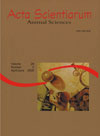<b>Total solids and egg components yield of white and brown laying hens</b> - DOI: 10.4025/actascianimsci.v29i2.222
Abstract
The experiment was conducted to evaluate the influence of lines, age of the hens and egg size on egg weight, albumen and yolk percentages, and total solid concentrations of the albumen and yolk characteristics. Seven hundred twenty eggs were randomly distributed in a 2 x 3 x 3 factorial scheme: lines of the hens (White - Lohmann LSL and Brown - ISA Brown), age of the hens (25-26, 47-48 and 62-66 weeks), and egg size (medium, large and extra), totalizing 18 treatments with 40 replicates of one egg each. The results showed that eggs produced by the white hens had higher yolk percentage than those produced by the brown hens, irrespective of the age. As the age of hens increased, albumen percentage decreased and yolk percentage increased for both lines. Eggs produced by older hens had smaller albumen and yolk solid concentrations than younger hens. It was concluded that eggs produced by white layers are more indicated for egg-processing industry due to highest yolk yield. Egg size does not influence the concentration of total solids and the age of the hen is a decisive factor of the albumen and yolk yield.Downloads
Download data is not yet available.
Published
2007-11-13
How to Cite
Faria, D. E. de, Silva, F. H. A., Rizzo, M. F., Sakamoto, M. I., Araujo, L. F., & Junqueira, O. M. (2007). <b>Total solids and egg components yield of white and brown laying hens</b> - DOI: 10.4025/actascianimsci.v29i2.222. Acta Scientiarum. Animal Sciences, 29(2), 173-177. https://doi.org/10.4025/actascianimsci.v29i2.222
Issue
Section
Nonruminant Nutrition
DECLARATION OF ORIGINALITY AND COPYRIGHTS
- I Declare that current article is original and has not been submitted for publication, in part or in whole, to any other national or international journal.
The copyrights belong exclusively to the authors. Published content is licensed under Creative Commons Attribution 4.0 (CC BY 4.0) guidelines, which allows sharing (copy and distribution of the material in any medium or format) and adaptation (remix, transform, and build upon the material) for any purpose, even commercially, under the terms of attribution.
Read this link for further information on how to use CC BY 4.0 properly.
0.9
2019CiteScore
29th percentile
Powered by 








































